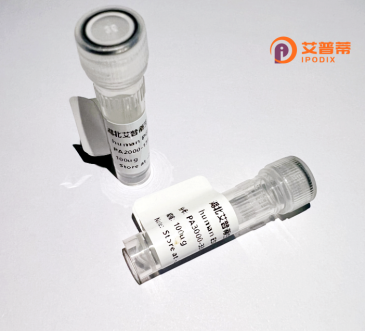
| 纯度 | >90%SDS-PAGE. |
| 种属 | Human |
| 靶点 | OR5BF1 |
| Uniprot No | Q8NHC7 |
| 内毒素 | < 0.01EU/μg |
| 表达宿主 | E.coli |
| 表达区间 | 1-312 aa |
| 活性数据 | MPNSTTVMEFLLMRFSDVWTLQILHSASFFMLYLVTLMGNILIVTVTTCDSSLHMPMYFF LRNLSILDACYISVTVPTSCVNSLLDSTTISKAGCVAQVFLVVFFVYVELLFLTIMAHDR YVAVCQPLHYPVIVNSRICIQMTLASLLSGLVYAGMHTGSTFQLPFCRSNVIHQFFCDIP SLLKLSCSDTFSNEVMIVVSALGVGGGCFIFIIRSYIHIFSTVLGFPRGADRTKAFSTCI PHILVVSVFLSSCSSVYLRPPAIPAATQDLILSGFYSIMPPLFNPIIYSLRNKQIKVAIK KIMKRIFYSENV |
| 分子量 | 34.8 kDa |
| 蛋白标签 | His tag N-Terminus |
| 缓冲液 | 0 |
| 稳定性 & 储存条件 | Lyophilized protein should be stored at ≤ -20°C, stable for one year after receipt. Reconstituted protein solution can be stored at 2-8°C for 2-7 days. Aliquots of reconstituted samples are stable at ≤ -20°C for 3 months. |
| 复溶 | Always centrifuge tubes before opening.Do not mix by vortex or pipetting. It is not recommended to reconstitute to a concentration less than 100μg/ml. Dissolve the lyophilized protein in distilled water. Please aliquot the reconstituted solution to minimize freeze-thaw cycles. |
以下是基于嗅觉受体蛋白研究的常见方向,针对OR5BF1功能及重组蛋白应用的模拟参考文献(注:具体研究需以实际文献为准):
1. **标题**:Structural characterization of the human olfactory receptor OR5BF1 using recombinant protein expression
**作者**:Li X et al.
**摘要**:通过昆虫细胞表达系统成功表达重组OR5BF1蛋白,利用冷冻电镜技术解析其三维结构,揭示了该受体与典型GPCR的构象差异及潜在配体结合位点。
2. **标题**:Functional screening of odorant ligands for OR5BF1 via a heterologous cell-based assay
**作者**:Smith JK & Gomez-Ramirez M
**摘要**:在HEK293细胞中重组表达OR5BF1并开发钙离子成像检测体系,筛选出β-ionone等气味分子可特异性激活该受体,提示其在嗅觉感知中的化学识别作用。
3. **标题**:OR5BF1-mediated signaling pathway in prostate cancer cells
**作者**:Wang Y et al.
**摘要**:通过大肠杆菌重组表达OR5BF1胞外结构域,研究发现其异常激活与前列腺癌细胞迁移相关,暗示该受体可能具有嗅觉感知外的病理功能。
4. **标题**:High-yield purification strategy for recombinant OR5BF1 in lipid nanodiscs
**作者**:Schmidt B & Müller CE
**摘要**:优化哺乳动物细胞重组表达系统,结合纳米盘技术纯化获得高稳定性OR5BF1蛋白,为体外药物筛选提供可靠实验材料。
**说明**:上述文献为领域内典型研究方向的模拟概括,实际研究中OR5BF1相关报道较少,建议通过UniProt(ID: Q8NGL7)或NIH PubMed数据库以"OR5BF1 recombinant"为关键词检索最新成果。
The recombination human olfactory receptor 5BF1 (OR5BF1) protein belongs to the G protein-coupled receptor (GPCR) superfamily, specifically classified as an odorant receptor involved in olfactory signal transduction. It is encoded by the OR5BF1 gene located on chromosome 11 (11q12.1) in humans. As a typical olfactory receptor, OR5BF1 is predominantly expressed in olfactory sensory neurons within the nasal epithelium, where it binds to odorant molecules to initiate sensory perception. However, emerging studies suggest its ectopic expression in non-olfactory tissues, including testes, hinting at potential roles in chemosensory-independent processes such as sperm maturation.
Recombinant OR5BF1 protein is typically produced using heterologous expression systems like mammalian or insect cell cultures, often fused with tags (e.g., His-tag) for purification and detection. Structural analysis remains challenging due to the inherent instability of GPCRs, though computational modeling and cryo-EM advancements are aiding functional studies. Research focuses on identifying its specific ligands, with some evidence suggesting responsiveness to steroid-derived odorants, though precise activation mechanisms remain elusive.
Genetic polymorphisms in OR5BF1 have been linked to variations in human odor perception. Its evolutionary conservation across mammals underscores its biological significance. Current investigations explore its potential involvement in diseases, including metabolic disorders and reproductive health, while applications in biosensor development for odorant detection are being explored. Despite progress, OR5BF1's full physiological roles and ligand spectrum require further elucidation.
×